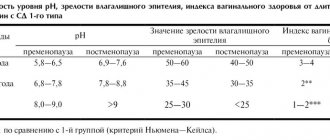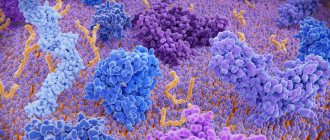Detailed description of the study
Von Willebrand factor (VWF) is a large protein that is a blood clotting factor and is involved in stopping bleeding. It ensures the formation of a clot of platelets at the site of vessel damage and protects factor VIII, an antihemophilic plasma protein, from destruction.
The hemostatic system is a combination of mechanisms that are responsible for stopping bleeding when a vessel is damaged. First, a primary clot is formed due to the action of platelets and the walls of the vessel itself. Next, plasma proteins participate in the formation of a dense blood clot, which finally eliminates the defect. Von Willebrand factor, unlike other clotting factors, is directly involved in the formation of a blood clot.
Von Willebrand factor is synthesized in the bone marrow. In addition, it is produced by cells lining the inner surface of blood vessels (endothelium). The protein is able to bind to factor VIII, and if a vessel is damaged, it delivers it to the site of vessel damage for effective blood clotting. Also, von Willebrand factor binds to a protein on the surface of platelets, which activates their gluing to each other (adhesion). Another of its functions is the attachment of platelets to collagen, which is released when the integrity of the vascular wall is violated. All of these processes ultimately lead to successful stopping of bleeding and restoration of the integrity of the blood vessel.
A defect in the gene that responds to the production of von Willebrand factor leads to the development of hereditary coagulopathy - von Willebrand disease. There are three types of the disease. The first type is the most common. At the same time, the amount of VWF in the blood is moderately reduced and functions are not impaired. The second type is when the functional activity of VWF is impaired, even with sufficient levels in the blood. The third type is severe, observed quite rarely, the amount of EF is sharply reduced.
Clinically, the disease manifests itself as prolonged bleeding of various locations: from the nose, gums, gastrointestinal tract, uterus. The disease is characterized by the appearance of bruises that do not correspond to the size of the injury. Bleeding is also observed after small cuts that do not stop for a long time; bleeding time increases after operations and dental procedures, such as tooth extraction.
In severe forms of von Willebrand disease (often type 3), symptoms similar to hemophilia may occur due to factor VIII deficiency. Muscle hematomas and hemarthrosis appear - hemorrhages into the joint cavity. The consequences of the disease are cerebral hemorrhages, bleeding from internal organs, decreased hemoglobin in the blood (anemia).
Determining the amount of von Willebrand factor in the blood is necessary to assess the state of the coagulation system and timely diagnosis of von Willebrand disease, which leads to bleeding.
Inherited illness: why is von Willebrand disease dangerous?
Today, according to official statistics, about 8.5 thousand patients suffer from hemophilia in Russia, although this pathology was once considered a royal disease. Hemophilia is a hereditary disease that usually affects only men, while women act as carriers of the gene. Of course, the most famous carrier of hemophilia in history was Queen Victoria. Presumably, this mutation occurred in her de novo genotype, since there were no hemophilia patients in her parents' families. The most common forms of the disease are classical hemophilia type A and hemophilia type B, in which a deficiency of clot-forming factor VIII or plasma factor IX (Christmas) develops.
Unlike hemophilia, which affects only men, there is another hereditary hemorrhagic diathesis that also affects women - von Willebrand disease. This pathology, inherited in an autosomal dominant manner, is much more difficult to diagnose and often the patient learns about it only during severe injuries, surgical interventions and other critical conditions. In the world, von Willebrand disease occurs in 1 person out of 100. In Russia, according to official data, the prevalence is 0.001%, but many experts believe that the real number of patients is much higher. The low detection rate of the disease can be explained by the predominance of mild and asymptomatic forms, as well as the complexity of diagnosis. The majority of patients with hemophilia and von Willebrand disease are people of working age, which is why measures aimed at preventing complications come to the fore. In von Willebrand disease, there is a deficiency of von Willebrand factor, a protein that plays an important role in regulating platelet adhesion to subendothelial collagen and protects factor VIII from proteolysis. In addition, the serotonin content decreases and pathological dilatation of blood vessels and an increase in their permeability develop. It is worth emphasizing that it is with this pathology that the longest bleeding is observed, since all three parts of hemostasis are damaged. There is also acquired von Willebrand syndrome, characteristic of patients with autoimmune and lymphoproliferative diseases and caused by the formation of an inhibitor against von Willebrand factor.
The clinical course of von Willebrand disease can significantly reduce the quality of life, lead to early and persistent disability, and in severe cases even death. For a long time, the disease was considered as a form of hemophilia, since many manifestations of von Willebrand disease are similar to the symptoms of this nosology. However, treatment for hemophilia has not always been effective in cases of von Willebrand disease. In this regard, in March 2015, a new List of Medicines came into force, in which the treatment of von Willebrand disease was included in a separate item.
The most pathognomonic symptoms of von Willebrand disease include bleeding from the mucous membranes of the mouth, nose, internal organs, as well as the appearance of long-lasting bruises. Unlike hemophilia, which is diagnosed at birth, von Willebrand disease, especially its mild forms, is diagnosed only in adolescence or during invasive procedures, when bleeding can be difficult to stop. The severity of manifestations can vary from mild forms to very severe variants with prolonged bleeding of a wide variety of localizations, the formation of hematomas and hemorrhages in soft tissues, joints and internal organs. With such forms, children became disabled by the age of 12-15 and rarely lived to be 30 years old.
Today, thanks to the achievements of world science, patients with bleeding disorders can live a full life, get an education, work, and successfully socialize. The duration and quality of their life is at the same level as that of a healthy person. If von Willebrand disease is suspected, a blood test is necessary for the qualitative and quantitative characteristics of von Willebrand factor. The most commonly used diagnostic tests are ristomycin cofactor activity, ristomycin platelet aggregation, collagen von Willebrand factor binding activity, factor VIII von Willebrand factor binding activity, or multimer assay. However, there are still several issues that need to be addressed. How often should diagnostics be carried out? Which patients need it? How to evaluate the norm? Moreover, the activity of von Willebrand factor is constantly changing. It can increase with stress or decrease with decreasing estrogen concentrations in women.
Treatment of von Willebrand disease is divided into specific and nonspecific. The most important pathogenetically determined point is the administration of hemotherapy containing a complex of factor VIII and von Willebrand factor. The question remains open: what bleeding should be treated with replacement therapy and what should be the dose of drugs with von Willebrand factor? Transfusion should begin several days before the proposed surgical operations, since correction of hemostasis occurs gradually. Transfusion of platelets or the use of drugs that affect platelets are not effective, since in this case platelet dysfunction occurs secondary. For mild to moderate severity and the development of microcirculatory type bleeding, the effectiveness of aminocaproic acid has been proven.
Currently in Russia there is a program “7 nosologies”, which is intended for the treatment of patients with seven rare and expensive nosologies at the expense of the federal budget. Thanks to this program, the percentage of disability has significantly decreased, the quality of life of patients has improved and the risk of life-threatening bleeding has decreased. The advantage of the “7 nosologies” program was the provision of medicinal care according to nosological principle, and not according to disability status. It is extremely important to maintain the current system of drug supply and centralized procurement of drugs, since for some categories of patients this program becomes the only opportunity to support and preserve their own lives.
Bibliography:
- Christine A. Lee, Rezan A. Kadir, Peter A. Kouides: Inherited Bleeding Disorders in Women.
- Chandler WL, Peerschke EI, Castellone DD, Meijer P (June 2011). “Von Willebrand factor assay proficiency testing. The North American Specialized Coagulation Laboratory Association experience." Am. J. Clin. Pathol. 135(6):862–9.
- "Molecular basis of von Willebrand disease and its clinical implications." Haematologica 89 (9): 1036. 1 September 2004.
Prepared by:
Drapkina Yu.S.
References
- Zozulya, N.I., Kumskova, M.A., Likhacheva, E.A. and others. Clinical guidelines for the diagnosis and treatment of von Willebrand disease. — Congress of Hematologists of Russia, 2021. — 30 p.
- Chernova E.V. von Willebrand factor. — Bulletin of the North-Western State Medical University named after. I.I. Mechnikova, 2018. - T. 10. - No. 4. - P. 73–80.
- Chubukov, Zh.A. Von Willerbrand factor and endothelial dysfunction under stress. - Problems of health and ecology, 2012. - pp. 40-44.
- Pathophysiology: textbook: in 2 volumes / ed. V.V. Novitsky, E.D. Goldberg, O.I. Urazova. — 4th ed., revised. and additional - GEOTAR-Media, 2009. - T. 2. - 640 p.
RESULTS EVALUATION
An increase in the level of von Willebrand factor is observed with massive damage to the endothelium (hemorrhagic vasculitis, atherosclerosis, diabetes mellitus, tumors, gestosis), with thrombosis and disseminated intravascular coagulation, and may also indicate physiological activation of the endothelium with the release of von Willebrand factor into the bloodstream (physical exercise , pregnancy, stress, trauma, administration of adrenaline, vasopressin). A slow and long-term observed increase occurs in acute coronary syndromes, liver cirrhosis, in the postoperative period, cancer, pregnancy, diabetes, hemolytic anemia.
A decrease in the level of von Willebrand factor is observed in hypothyroidism, systemic lupus erythematosus and other autoimmune diseases. Hereditary disorders, expressed in a decrease in the amount of von Willebrand factor or changes in its functional properties, cause von Willebrand disease (VWD), the most common congenital hemorrhagic disease. BV is detected in approximately 1% of the population; however, the number of clinically significant cases is smaller—about 1/100,000 people.
Why does von Willebrand disease (VWD) develop?
In most cases, the pathology is caused by a gene defect on chromosome 12. Types 1 and 2 of von Willebrand disease (60-80% of cases) are inherited in an autosomal dominant manner. That is, BV occurs in every generation of the family, in males and females.
The third type of BV is when both parents have a mutant gene. It is transmitted recessively, so it occurs only in 5% of cases, more often in consanguineous marriages.
Von Willebrand syndrome can be acquired. These are cases when a person suffers from autoimmune pathologies, hypothyroidism, oncology or diseases of the lymphatic system.
How to treat von Willebrand disease
The basis of treatment for von Willebrand disease is transfusion replacement therapy. It is aimed at normalizing all parts of hemostasis. Patients are administered hemotherapy containing von Willebrand factor - antihemophilic plasma and cryoprecipitate. Replacement therapy helps to increase the biosynthesis of the deficient factor in the body.
- A pressure bandage, hemostatic sponge, and treatment of the wound with thrombin will help stop minor bleeding.
- The following medications have a hemostatic effect: Desmopressin, antifibrinolytics, hormonal oral contraceptives for uterine bleeding.
- Fibrin gel is applied to the bleeding wound.
- For hemarthrosis, a plaster splint is placed on the leg, cold is applied and the limb is elevated. In the future, patients are prescribed UHF and limiting the load on the joint. In severe cases, joint puncture is performed under local anesthesia.
To treat blood diseases of types 1 and 2, Desmopressin is used, a drug that stimulates the release of VWF into the systemic circulation. It is available in the form of a nasal spray and solution for injection. When this drug is ineffective, replacement therapy with VWF plasma concentrate is performed.
Antifibrinolytics include aminocaproic and tranexamic acids. They are administered intravenously or taken orally. Preparations based on these acids are most effective for uterine, gastrointestinal and nasal bleeding. Tranexam is the mainstay of treatment for mild forms of BV. In severe cases, the drug is used in combination with specific hemostatics - “Etamsylate” or “Dicynon”.
Diagnostics
Von Willebrand disease is quite difficult to detect. It is most often diagnosed in adolescents. To make the correct diagnosis, the doctor must study the family history in detail and carefully interview the patient. The presence of hemorrhagic syndrome and complicated heredity make it possible to suspect this pathology.
To confirm suspicions, the doctor will prescribe the following diagnostic measures to the patient:
- All young couples who are planning a pregnancy, but are at risk, must undergo genetic tests aimed at identifying the mutated gene.
- The patient's blood is examined for the activity of von Willebrand factor, and its qualitative and quantitative characteristics are studied.
- A blood coagulogram and a general blood test are performed.
- To detect hemarthrosis, X-ray examination of the joints, or MRI and arthroscopy are indicated.
- Internal bleeding can be detected using ultrasound examination, as well as during laparoscopy.
- A stool test for occult blood is performed.
- It is also possible to perform a tourniquet and pinch test.







